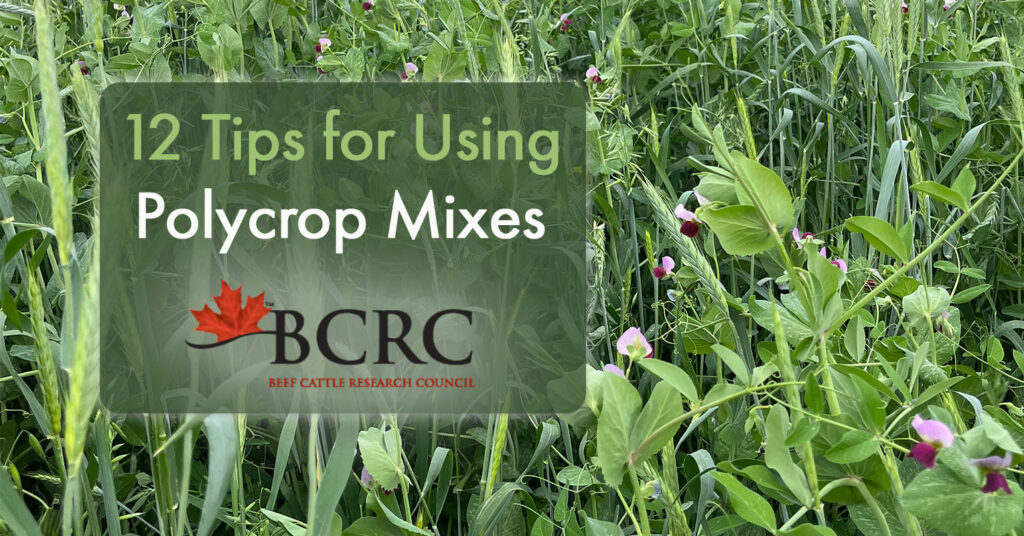
Cover crops are typically diverse, annual plant mixtures seeded with the intent to “cover” the ground and improve soils. Cover crops may include biennial or perennial species, and can be grazed, baled, or used for silage, depending on the goals of the product.
| Key Points |
|---|
| Cover crops are simple or diverse mixes of annual and sometimes biennial or perennial species that are planted in order to “cover” the ground. |
| Proponents of cover crops plant them to increase soil organic matter, improve water infiltration, improve the health of soil microbial communities, reduce the need for fertilizer inputs, and suppress weeds. |
| Common cover crop mixes include a blend of warm-season and cool-season plants, grasses or cereals, legumes, and Brassica species. |
| Cover crops may be grazed, baled, or put up as silage, depending on the mix and goals of the producer. |
| A feed analysis should be done prior to grazing or feeding cover crops. |
| Some cover crop plants, such as Brassica species, may accumulate excess sulphates and nitrates, which can lead to toxicity in cattle when consumed. |
| When introducing cattle onto a cover crop, move the cattle when they are full and not hungry. |
| Producers may want to control animal access to the crop and prevent selective grazing by using electric fence. |
| To slow down the passage of manure and improve nutrient absorption, some producers place additional roughage or low quality forage source in the field, that cattle can eat free choice. |
| Seed mixes often contain large and small-seeded species which have different seeding depth requirements. When possible, seed larger seeded plants deeper and plant smaller seeded species at a shallower depth. This can be done using multiple passes, or placing seed at different depths using side-banding drills. |
| Crops can be seeded using drills, aerial seeding, or broadcasting. Seeding rates will vary by method and specialized equipment may be needed. |
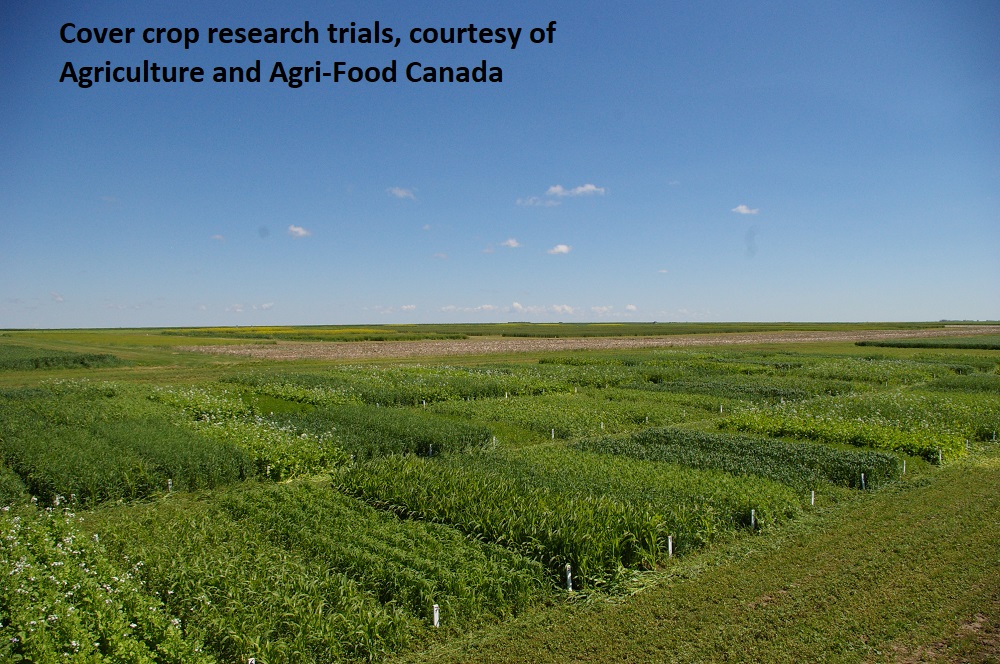
Cover crop goals and objectives
Cover crops are also referred to as polycrops, polycultures, and cocktail crops.
Proponents suggest that you can use cover crops to meet any number of goals, whether it is to increase productivity, improve soil health, increase water infiltration, control weeds, provide grazing, or reduce the need for inputs such as fertilizer. The overall goal or end use of the crop will largely determine the type of cover crop or mix seeded, when it is planted, and how it is managed.
Cover crops can be a valuable and quick-growing source of forage for livestock, and provide grazing in the same year the crop is seeded. Cover crops may also allow cropland and pastures to be more efficient with water and nutrient cycling, and less reliant on costly inputs such as fertilizer.
Many producers seed cover crop mixes, often called “cocktails,” in order to benefit the soil ecosystem, improve soil aggregation, and support a variety of soil microbes, fungi, and other biodiversity, such as earth worms. Some farmers use cover crops to incorporate into the soil as a green manure or plough-down crop in order to increase organic matter and allow for more efficient nutrient recycling. Some cocktail crop mixes may be useful in utilizing excess water in a field that would otherwise be water logged. Other mixes may include plant species selected for their drought-tolerant qualities and their ability to make the most efficient use of existing moisture. Other cover crops, such as fall rye, are planted to reduce soil erosion.
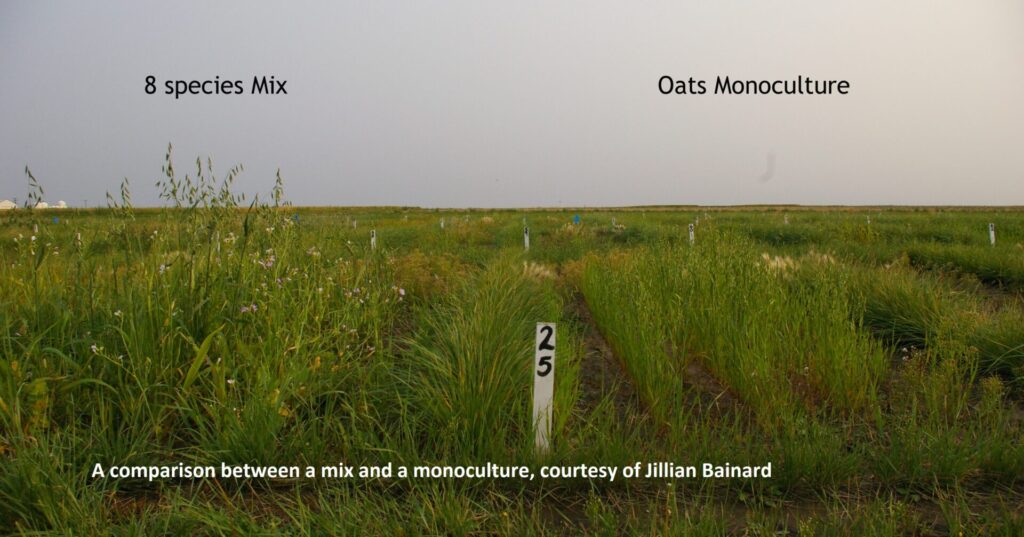
Cover crops also provide potential opportunities for cash crop farmers and livestock farmers to collaborate. Cash crop producers may want to incorporate cover crops on their fields to improve soils and reduce the need for costly crop inputs, however they don’t have a way to remove the crop via livestock. Partnering with cattle producers to remove the residue by grazing or baling can provide an additional revenue stream and in the case of grazing, provide additional bacteria and nutrients on the landscape.
Cover crops, because of their diversity, are often more resistant to pests such as insects and diseases. Research has shown that polycrops are more productive than monocultures and may be better able to withstand variable weather conditions such as drought.
There can be many rewards from seeding cover crops however there are some risks as well. Cover crops require careful planning. Paying close attention to timelines, especially seeding windows, will directly impact the success of the crop.
Seed mixes
Cover crop seed mixes may be comprised of four to ten species, twenty or even more.
A mixture of cover crop species is usually recommended, and may include both cool season species (i.e. a C3 plant such as barley) and warm season species (i.e. a C4 plant like millet) species, broad leaved species, legume species, and Brassica species. Legumes are often included to help the site fix nitrogen, and Brassica plants may be added to help suppress weeds or provide large channels (i.e. roots) for water to infiltrate down through.
Using a mix of cover crop species maximizes photosynthesis, allowing solar energy to be captured at different heights and angles. Different cover crop species will also have different rooting zones, therefore impacting soils at different depths.
Producers who have fields that are confirmed to have clubroot infestation should evaluate the risk of incorporating a Brassica in their mix. As well, some cover crop species (i.e. hairy vetch) may behave differently outside of a cover crop setting, and can potentially become invasive.
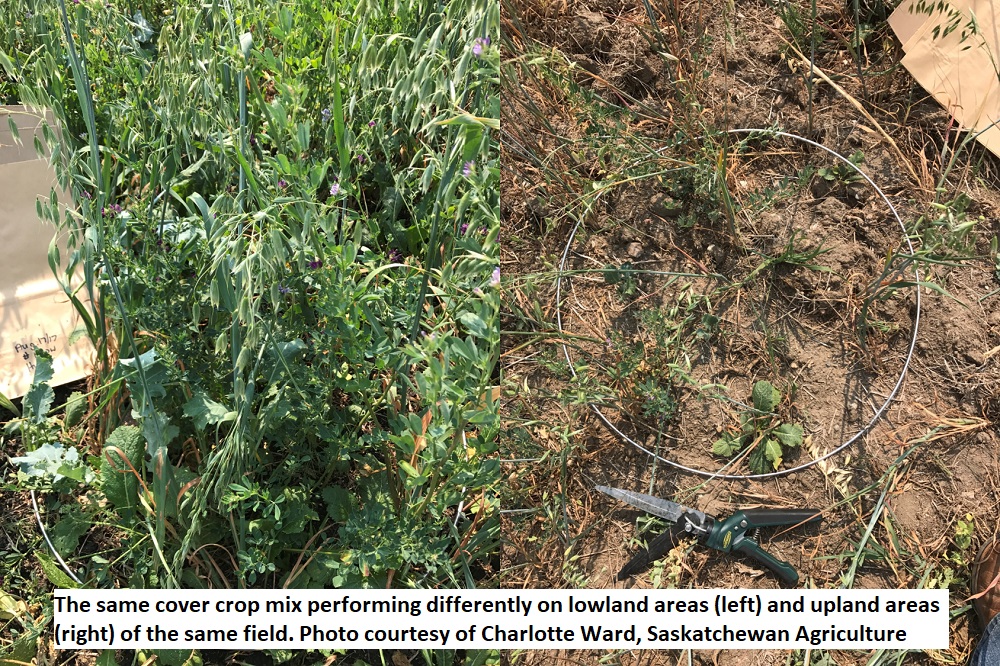
Grazing cover crops
From an animal standpoint, a forage cocktail also provides cattle with a diet that is nutritionally diverse. A mix may include species such as clover, a forage Brassica (i.e. turnip, radish), barley, or peas. Each plant species may reach maturity at slightly different times, therefore providing green forage continuously through the growing season. Producers may seed a cover crop to provide green forage during the “summer slump” when conventional forages are mature and quality is declining.
Using a combination of plants rather than a single forage species helps to increase the overall yield potential of the crop. Producers will want to manage cover crops through grazing management strategies, such as temporary fencing, that allow appropriate and timely grazing that matches the species and their stage of growth.
Current research trials are taking place to evaluate the effects of what happens when cover crop residue is completely removed, partially removed, or left.
Animal considerations

Forage quality in cover crops can be similar or even better than that of monoculture forages. Research has shown that mixes may have higher protein and lower neutral detergent fibre (NDF) that there may be beneficial micronutrients including copper, calcium, iron, nitrogen, phosphorus and sulfur that aren’t present in monocultures.
If producers are planning on using cover crops for silage, greenfeed, grazing, or another controlled feeding methods, feed testing is recommended to identify any potential nutrient or anti-quality issues.
Some cover crop plants, such as Brassica species, can accumulate excess sulphates and nitrates, which can lead to toxicity in cattle when consumed.
Depending on soil fertility conditions and species selection, some cover crop plants, such as Brassica species, can accumulate excess nitrates and sulfates. Brassica species often withstand frost and may be the only remaining plants green and growing during a fall grazing period so it’s important that producers pay attention to their animals for symptoms of nitrate or sulfate toxicity. As well, consider potential problems with cumulative levels of nitrates or sulfates that may be present in the stock water. Other cover crop species may cause grain overload if animals are allowed to selectively graze, so take steps to prevent that from occurring by only allowing a portion of the field to be accessed at a time.
Some species within a forage cocktail do not have a lot of fibre, particularly as species regrow following grazing. Cattle producers may want to include roughage in these grazing fields, even by providing straw bales or slough hay, to slow down the passage of forage through the digestive system and increase the nutrient uptake.
Producers are urged to pay attention to their cattle when grazing or feeding cover crops. Use common management practices, such as the following, to avoid problems:
- Avoid early morning moves and only turn cattle out onto new cover crops when the cattle are full;
- Avoid moving cattle to a new cover crop during weather changes;
- Avoid moving cattle to a new cover crop following a major handling event (i.e. processing, preg-checking, following a long trailing event);
- Prevent animals from selectively grazing (i.e. choosing the “best, leaving the rest”) by allowing them to graze a portion of a field at a time and ensuring an appropriate stocking rate;
- Monitor animals for signs of reduced feed intake, incoordination, panting, or other signs of nutritional toxicity.
Seeding considerations
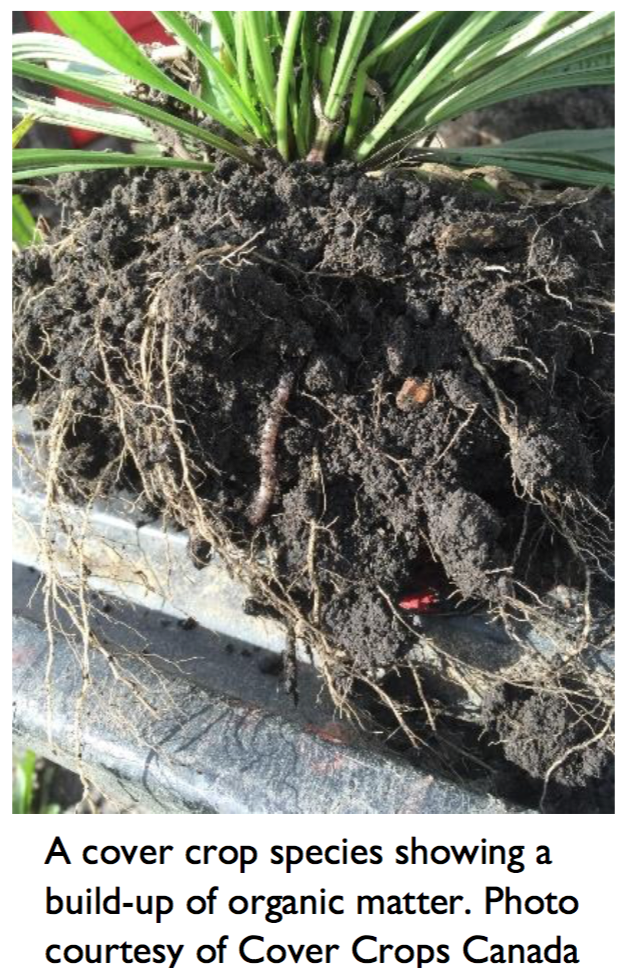
When seeding a diverse mix of species, the optimal seeding and harvesting time for some species in the mix may be the opposite as what is needed for the others. Also, some cover crop mixtures may be best seeded before traditional seeding times, after harvest, or following a winter crop. Many annual cover crops can be seeded later than conventional annual crops, which can offset some of the workload. As long as moisture is sufficient and a cover crop is established, the later seeding date also results in fresh forage later in the summer when other forage material may already be exhausted or past its prime.
Cover crops can be seeded using several different implements. Drills, broadcast seeders and even aerial seeding can be used to plant a cover crop, however consider the potential need for extra equipment or extra seed. Also consider the soil bed you are seeding into, in order to maximize soil-seed contact and crop emergence/establishment.
Seeding rates will vary according to the diversity of mix, the soils and type of site being seeded, and the method of planting. Seeding rates have a large impact on the cost, as does the number and variety of species. There are several seeding cost calculators available to producers, including this version available at: http://decision-tool.incovercrops.ca/
Seeding dates should be planned strategically and will vary by location, weather conditions, and grazing management strategy. Some producers may opt to seed two crops in a season, where they silage the first crop and graze the second crop. Some situations may allow for a late-summer seeding following the early harvest of a winter cereal crop. Other producers sometimes seed fall or winter crops in the spring, for grazing later in the season and early in the next.
Seeding depth can be a challenge given the diverse seed size of all the species that may be in a mix. Small-seeded species, such as millet, may flourish best when planted relatively shallow, while other larger-seeded plants, such as corn or peas, will thrive when seeded deeper. If possible, producers with access to a drill that has a side-band option may want to put small–seeded crops in one tank and large-seeded crops in another tank to seed each group at the most appropriate depth. Another option may be to make two passes, one pass seeding the smaller-seeded group followed by another pass where the larger seeded group is planted. Another seeding depth alternative is to make a single pass at an intermediate depth that will suit the majority of the plants in the mix.
Weed control can be a challenge. Ensure the field has good weed control prior to seeding a cover crop and avoid seeding cover crops if there is an existing issue that will limit crop establishment. Weeds can get out of control especially if the crop is performing poorly. Depending on the row spacing or seeding method, there can be a lot of weeds between the rows and chemical control is not an option due to the mix of broadleaf and grassy species that are often in a cover crop mix. Certain species can be included in a cover crop specifically for weed control, in particular Brassicas, as they have been found to control weeds in some situations.
Interested in using cover crops?
- Evaluate your goals for cover crops. What is your intended outcome and what specific issues are you trying to resolve? Do you need to build organic matter or improve water infiltration? Are you concerned about soil erosion? What is motivating you? How will this fit in with you current cropping and grazing management?
- Evaluate your existing infrastructure. What sort of water development, fencing, or other infrastructure may you need in order to graze cover crops? Do you have the seeding equipment necessary to plant a cocktail crop? Can you rent the equipment you need?
- Look for informational resources. Do you have experience seeding cover crops or grazing them? Do you have someone you can contact or resources available?
- Evaluate grazing conditions as the season progresses. Have you performed a feed analysis? Are your cattle receiving all of the nutrients that they need to stay healthy? Do the nutrients match the stage and class that your cattle will be at during grazing?
Feedback
Feedback and questions on the content of this page are welcome. Please e-mail us.
Acknowledgments
Thanks to Dr. Jillian Bainard from Agriculture and Agri-Food Canada and Sarah Sommerfeld from the Saskatchewan Ministry of Agriculture for contributing their time and expertise in reviewing this page.
Ce contenu a été révisé pour la dernière fois en Juin 2019.
